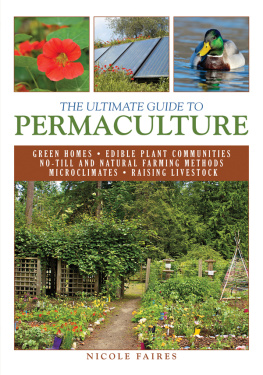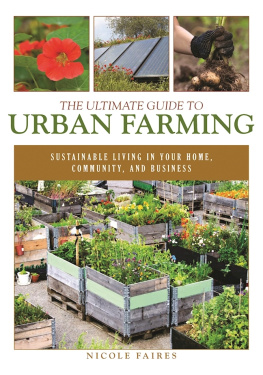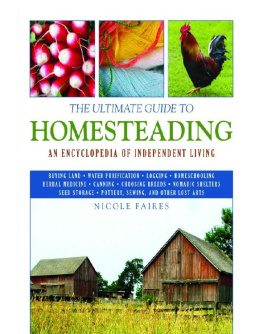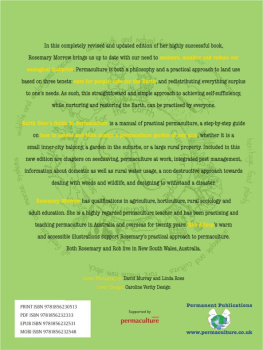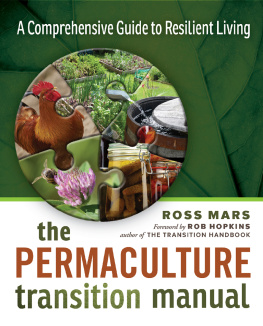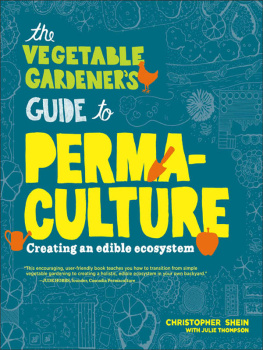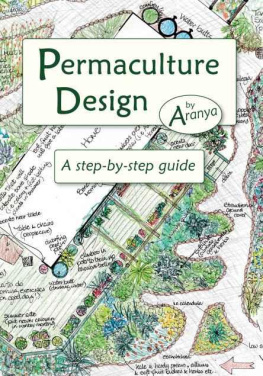Nicole Faires - The Ultimate Guide to Permaculture
Here you can read online Nicole Faires - The Ultimate Guide to Permaculture full text of the book (entire story) in english for free. Download pdf and epub, get meaning, cover and reviews about this ebook. City: New York, year: 2012, publisher: Skyhorse Publishing Company, Incorporated;Skyhorse Publishing (Perseus), genre: Children. Description of the work, (preface) as well as reviews are available. Best literature library LitArk.com created for fans of good reading and offers a wide selection of genres:
Romance novel
Science fiction
Adventure
Detective
Science
History
Home and family
Prose
Art
Politics
Computer
Non-fiction
Religion
Business
Children
Humor
Choose a favorite category and find really read worthwhile books. Enjoy immersion in the world of imagination, feel the emotions of the characters or learn something new for yourself, make an fascinating discovery.
- Book:The Ultimate Guide to Permaculture
- Author:
- Publisher:Skyhorse Publishing Company, Incorporated;Skyhorse Publishing (Perseus)
- Genre:
- Year:2012
- City:New York
- Rating:4 / 5
- Favourites:Add to favourites
- Your mark:
- 80
- 1
- 2
- 3
- 4
- 5
The Ultimate Guide to Permaculture: summary, description and annotation
We offer to read an annotation, description, summary or preface (depends on what the author of the book "The Ultimate Guide to Permaculture" wrote himself). If you haven't found the necessary information about the book — write in the comments, we will try to find it.
The Ultimate Guide to Permaculture — read online for free the complete book (whole text) full work
Below is the text of the book, divided by pages. System saving the place of the last page read, allows you to conveniently read the book "The Ultimate Guide to Permaculture" online for free, without having to search again every time where you left off. Put a bookmark, and you can go to the page where you finished reading at any time.
Font size:
Interval:
Bookmark:
Copyright 2012 by Nicole Faires
All Rights Reserved. No part of this book may be
reproduced in any manner without the express
written consent of the publisher, except in the case of
brief excerpts in critical reviews or articles.
All inquiries should be addressed to Skyhorse
Publishing, 307 West 36th Street, 11th Floor,
New York, NY 10018.
Skyhorse Publishing books may be purchased in bulk
at special discounts for sales promotion, corporate
gifts, fund-raising, or educational purposes. Special
editions can also be created to specifications. For
details, contact the Special Sales Department,
Skyhorse Publishing, 307 West 36th Street, 11th Floor,
New York, NY 10018 or .
Skyhorse and Skyhorse Publishing are registed
trademarks of Skyhorse Publishing, Inc., a Delaware
corporation.
www.skyhorsepublishing.com
10 9 8 7 6 5 4 3 2 1
Library of Congress Cataloging-in-Publication Data is available on file.
ISBN: 978-1-61608-644-2
Printed in China
Dedicated to my husband John,
who still doesnt let me quit,
and my three crazy girls. I hope someday
they look back
at our bus years with love.
Special thanks to:
Renato Faustini, for the amazing solar house models;
Skyhorse Publishing, for making all my dreams come true;
my editor, Jenn McCartney, for being awesome.
| | Introduction |
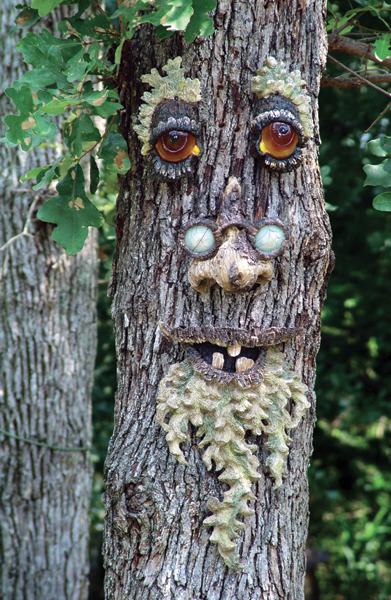
The fish trap exists because of the fish. Once youve gotten the fish, you can forget the trap. The rabbit snare exists because of the rabbit. Once youve gotten the rabbit, you can forget the snare. Words exist because of meaning. Once youve gotten the meaning, you can forget the words. Where can I find a man who has forgotten words so I can talk with him?
~ Chuang Tzu
First, a disclaimer: Does the label Ultimate Guide mean that this book will contain all of the knowledge about permaculture that exists or could exist in the world? Will it answer every question that could ever be asked? No, of course not. It was written by one person in less than one lifetime and cannot possibly contain everything.
This book contains all of the core fundamentals. It whittles down all of the information and theory and experience into a tool that you can use in a practical way.
ULTIMATE 
adjective
basic or fundamental: the ultimate constituents of anything that exists are atoms
Permaculture is a vast field. There are countless courses available to help you increase your knowledgefrom introductory weekend classes to full certificate and diploma programs at respected institutions. If you are interested in pursuing permaculture as a career, or if you simply want to dive head first into a bottomless lake of sustainability knowledge, take a course. There you will learn all of the philosophy and theory behind the strategies and skills outlined here. This book, however, was written for everyone else. It is for those who want to begin applying permaculture principles in their own life right away. It is for those who want to become self-reliant, self-sufficient, sustainable, and possibly even develop a community of like-minded people.
I wrote this book while living in a 37-foot bus, traveling from place to place with my husband and three children. However, I am not the proverbial hippie bus mother. I am a geek who likes to experiment with sociological questions, and permaculture is the ideal way to do this. This kind of curiosity spilled over into my own life in the form of our custom-built nomadic home, to which we applied permaculture principles. When you have five or six people living in a 350-square-foot home, inefficiencies and open loops of unsustainability are thrown up into your face as the chaos grows. Chaos from the waste of human living must be managed on a daily basis, and there are no services to truck it away for you. Through this learning process, every square inch of space was analyzed for functionality and impact. There was also the question of making a living while we were nomadic. How does a family survive without anyone having a regular job? This question is eventually asked by all who are interested in sustainability, whether their motivation is to grow food for a living or comes from a desire to simply escape from the race. Permaculture taught us to think critically, outside the box. Rather than increasing our income to improve our lifestyle, we dramatically decreased our expensesand our footprint.
At its essence, permaculture is a series of questions. We not only ask where the water comes from, but also where it will go when we are done with it. We ask how to cool our house without electricity and without work. We ask how to grow food abundantly without backbreaking labor or waste. On a greater scale, we ask how we can live as biological organisms within the context of an ecological system, and as humans in a community, without the need to rationalize away guilt caused by knowing our own cost to the environment and to other, less fortunate people.
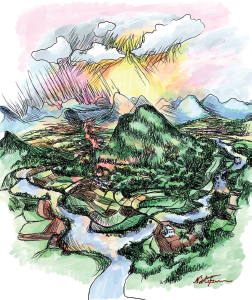
Not only does permaculture ask the right questions, it has all the answers, encased in a package of design and lifestyle strategies. Up until recent years, permaculture has been heroically promoted and taught by a few groups of ecologically minded people. Many of these people are dedicated legacies of the hippie era, and some are youngsters who are tired of our consumerist society. This anti-establishment culture has had both a positive and a negative impact on the movement as a whole. These hippies and hipsters have protected permaculture and promoted it, albeit within a relatively small minority. They have built up a community that is deeply passionate about the principles behind it. On the other hand, this exclusiveness and protection has slowed the spread of permaculture to the rest of society. If these answers are to be implemented by everyone, the culture surrounding a subculture will inevitably change.
If I have been able to impartially teach the basic principles and how-to aspects of permaculture, I will feel as though I have succeeded. I hope to dust away the cobwebs of preconceived assumptions and ideologies and in so doing further my goal of creating a better, more sustainable world that I can be proud to hand over to my grandchildren.
Bill Mollison and David Holmgren, while both equal co-creators of permaculture, disagreed on the spiritual side of things. Mollison, ever the scientist, wanted to distance the official practice of permaculture from any religious features that the community introduced. Holmgren, on the other hand, grew to believe that the spiritual aspects could not be ignored. If you participate in any permaculture design course (PDC), you are likely to be introduced to a variety of quasi-pagan and earth-centric faith practices, which many would argue are essential to a true understanding of permaculture. This book has purposely ignored this element in the quest for practicality and inclusiveness.
1 | | | What is Permaculture? |
Though the problems that face the world are increasingly complex, the solutions remain embarrassingly simple.
~ Bill Mollison
Font size:
Interval:
Bookmark:
Similar books «The Ultimate Guide to Permaculture»
Look at similar books to The Ultimate Guide to Permaculture. We have selected literature similar in name and meaning in the hope of providing readers with more options to find new, interesting, not yet read works.
Discussion, reviews of the book The Ultimate Guide to Permaculture and just readers' own opinions. Leave your comments, write what you think about the work, its meaning or the main characters. Specify what exactly you liked and what you didn't like, and why you think so.

